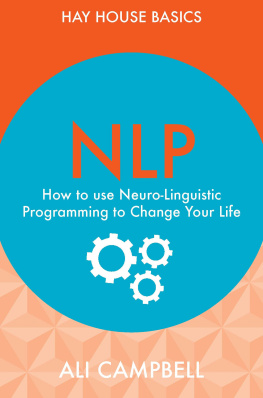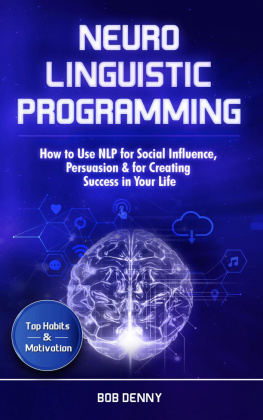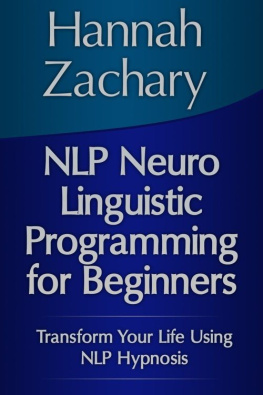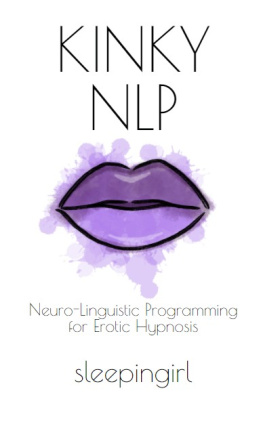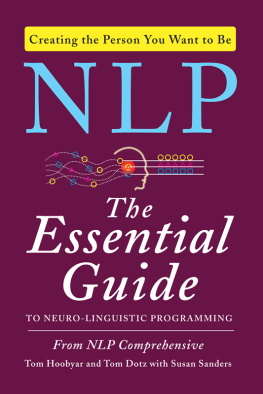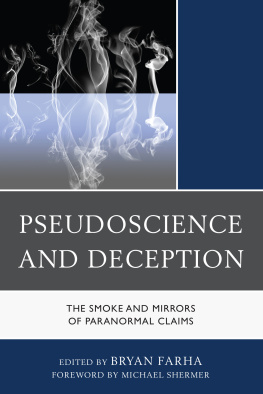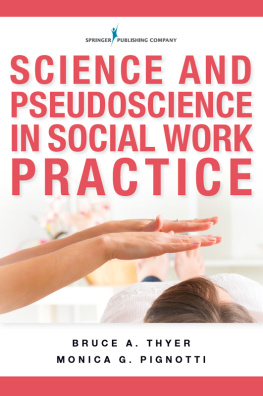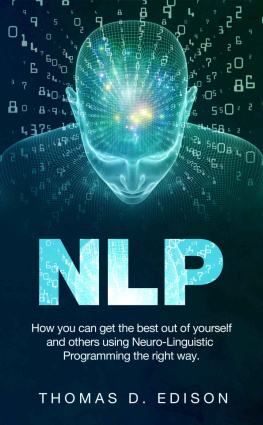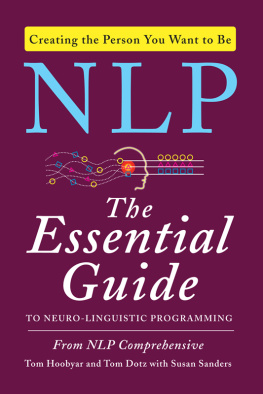Acknowledgements
We wish to thank the following people for their help in supplying documents and responding to queries:
Mary Catherine Bateson; Tony Clarkson; Judith DeLozier; Christina Hall; Michael Hall; David Lipset; Isabel Losada; Robert Spitzer; the Bateson archive, University of Santa Cruz; University of Santa Cruz Registry.
Thanks
To Richard Bandler and John Grinder without your efforts we would have no subject to write about. To Judith DeLozier, who epitomises for us the heart of NLP, and Christina Hall, whose teaching and understanding of language have been inspirational.
Our grateful thanks to the following people, and to anyone else we have neglected to mention who has helped us on this journey:
Suzanne Henwood, Richard Churches, Karen Moxom, Judith Lowe, Charles Faulkner, John Seymour, Judy Rees, Bruce Grimley, Lisa Wake, Trevor Day, Martin Weaver, Christine Miller, Frank Bourke, Susie Linder-Pelz, John Martin, Monique Esser, Dave Allaway, Ranjit Sidhu, Sue White, Josie Gregory, Eugene Sadler-Smith, John Wilson, Chris Rodgers.
The University of Surrey and the Higher Education Academy have both contributed funding that has helped to support this work.
Appendices
A timeline of NLP
Precursors
1890
Publication of William James The Principles of Psychology.
1893
Fritz Perls is born on 8th July in Berlin.
1901
Milton H. Erickson is born on 5th December in Aurum, Nevada.
1904
Gregory Bateson is born on 9th May in Grantchester, England, the son of geneticist William Bateson.
1916
Virginia Satir is born on 26th June on her parents farm in Neville, Wisconsin.
1933
First publication of Alfred Korzybskis Science and Sanity.
1940
John Thomas Grinder is born in Detroit, Michigan.
Gregory Bateson enters the USA as a resident.
1942
Milton Erickson addresses the precursor to the Macy Conferences, which Gregory Bateson attends.
1946
The inaugural Macy Conference (8th & 9th March 1946, New York), entitled Feedback Mechanisms and Circular Causal Systems in Biological and Social Systems. Gregory Bateson is a member of the core group.
1950
Richard Wayne Bandler is born on 24th February in New Jersey, USA.
1956
Publication of Millers The Magical Number Seven, Plus or Minus Two (Miller 1956).
1959
The Palo Alto Mental Research Institute is founded.
1960
Publication of Miller, Galanter and Pribrams Plans and the Structure of Behaviour (Miller, Galanter & Pribram 1960), source of the TOTE model.
1964
Fritz Perls, co-founder of Gestalt therapy, arrives at Esalen.
1966
The Brief Therapy Centre at Palo Alto is formed.
Origins
1967
Robert S. Spitzer meets Richard Bandler (Spitzer 1992:1).
Publication of Pragmatics of Human Communication (Watzlawick, Beavin & Jackson 1967).
1968
Publication of The Teachings of Don Juan: A Yaqui Way of Knowledge by Carlos Castaneda.
Grinder enrols at the University of California, San Diego, as a graduate student in the department of Linguistics.
1969
Grinder begins an academic year as a guest researcher in George Millers lab at Rockefeller University.
1970
Grinder gains his PhD, titled On Deletion Phenomena (Grinder 1971) from the University of California, San Diego.
Grinder takes up position as assistant professor at the University of California, Santa Cruz in the fall of 1970.
Kresge College (University of Santa Cruz) is founded.
Fritz Perls dies on 14th March.
1972
Bandler attends Satirs month-long workshop in Canada
Publication of Gregory Batesons Steps to an Ecology of Mind.
Bateson is appointed Visiting Professor, University of California at Santa Cruz.
Bandler starts to give workshops in Gestalt Therapy at Kresge College.
1973
Gregory Bateson joins Kresge College (at the end of 1973).
Spitzer publishes Eyewitness to Therapy (Perls 1973).
1974
Gregory Bateson, his wife Lois, and their daughter Nora move into the community near Ben Lomond.
Bateson makes Bandler and Grinder aware of Milton Ericksons work.
1975
Publication of The Structure of Magic (Bandler & Grinder 1975b), and Patterns of the Hypnotic Techniques of Milton H. Erickson, M.D. Volume I (Bandler & Grinder 1975a).
1976
According to Robert Dilts, the title Neuro-linguistic Programming first appears in print.
Publication of Structure of Magic II (Grinder & Bandler 1976) and of Changing with Families (Bandler, Grinder & Satir 1976).
1977
Publication of Banduras seminal paper on self-efficacy (Bandura 1977a).
Publication of Patterns of the Hypnotic Techniques of Milton H. Erickson, M.D. Volume II (Grinder, DeLozier & Bandler 1977).
Steve and Connirae Andreas are first introduced to NLP (Bandler & Andreas 1985b:2).
Development
1978
Bateson leaves Kresge College.
Not Ltd., run by Richard Bandler, Leslie Cameron-Bandler and associates, offering training and developments workshops (McLendon 1989:113).
Bandler and Grinder go their separate ways (McLendon 1989:117). Bandler buys Grinder out of the Society of NLP.
Grinder and DeLozier form Grinder, DeLozier & Associates.
1979
Frogs into Princes (Bandler & Grinder 1979) is published the first time Bandler and Grinder use the term Neuro-linguistic Programming in a book.
1980
Milton H. Erickson dies on 25th March.
Gregory Bateson dies on 4th July.
Publication of Neuro-Linguistic Programming: volume 1, the study of the structure of subjective experience (Dilts, Grinder, Bandler & DeLozier 1980).
1981
Publication of Trance-formations (Grinder & Bandler 1981).
In October of 1981, John Grinder and Richard Bandler signed an Agreement governing the specific commercial use and rights involved in their joint creation the technology of Neuro-Linguistic Programming. (Hall 2001:16)
1982
Publication of ReFraming (Bandler & Grinder 1982), Bandler and Grinders last joint publication).
1983
Publication of Roots of NLP (Dilts 1983).
NLP training begins in Vienna.
1985
Publication of Using Your Brain (Bandler & Andreas 1985b).
John Seymour Associates is formed in the UK.
Association for NLP (now ANLP) is formed in the UK.
First issue of Rapport magazine is published.
1987
Publication of Turtles All The Way Down (DeLozier & Grinder 1987), which marks the development of New Code NLP.
1988
Virginia Satir dies on 10th September.
Publication of An Insiders Guide to Submodalities (Bandler & MacDonald 1988).
1993
In the UK the first National Register of Psychotherapists is presented to the Government. It contains around 3000 names, of which 52 are NLP Psychotherapists (Lawley 1994:43).
1994
The first issue of NLP World: the intercultural journal on the theory and practice of neuro-linguistic programming, appears in March 1994, created and edited by G. Peter Winnington.
At a crossroads
1996
Bandler files a suit against Grinder.
1997


